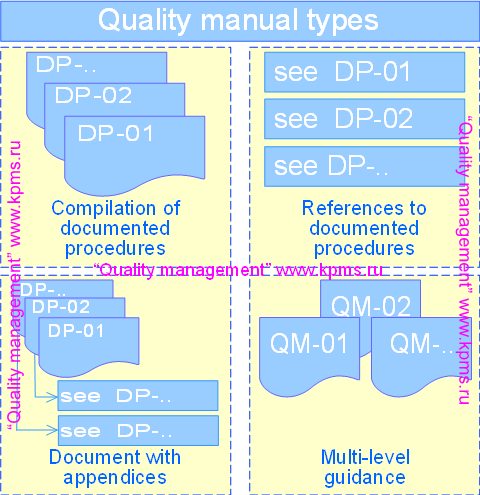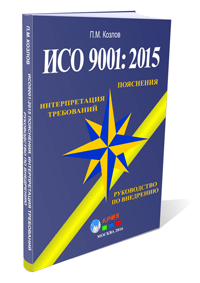The new version of the ISO 9001:2015 standard has eliminated the need for mandatory application of the quality manual. The organization can present all the information related to the quality system using various types of documented information. The organization, at its discretion, determines the type and composition of information for the presentation of the quality system. Nevertheless, many organizations continue to apply the quality manual, because this document makes it possible to systematize all aspects of the quality system.
Quality manual
The Quality Manual is the link between the quality policy, quality objectives, organization processes and performance results. The structure of the quality manual can be any. It is important that the quality manual contains basic information on the quality management system.
This document may include information about the quality system structure, scope of quality system activity, its elements and what employees need to do in order to do their job correctly.
If it is necessary to present how the organization fulfills the requirements of the ISO 9001:2015 standard, then the structure of the quality manual can repeat the sections of the standard. In this case, the structure of the quality manual may be as follows:
- Section 1 Introduction. Here is a brief description of the organization, types of activities and scopes of work, the general organizational structure of the enterprise.
- Section 2 Quality policy. An organization's quality policy can have a closed and an open part. As a rule, the open part of the quality policy is slogans and declarations that indicate the organization's focus on improving the quality of its work. This part of the policy is available for public review, both by employees of the organization and by people external to the organization. The closed part of the policy may contain strategies and goals that the organization will achieve in order to comply with the declarations and slogans specified in the open part of the policy.
The open part of the quality policy is drawn up in a separate document and "posted" for public viewing, and the closed part is indicated in the quality manual.
The placement of the quality policy as part of the quality manual is determined by issues of expediency. The quality policy should be regularly reviewed in accordance with the requirements of ISO 9001:2015. It will be appropriate to place the text of the quality policy as part of the Quality Manual if the periods of revision of the quality policy coincide with the periods of revision of the quality manual. If not, then such placement will cause additional difficulties.
- Section 3 Terms and Definitions – contains definitions of terms and abbreviations used in the quality manual.
- Section 4 Context of the Organization. This section presents the main working conditions of the organization and its quality management system:
- external and internal factors affecting the work;
- stakeholders (government agencies, organizations, communities, people who are influenced by the quality system and/or who can influence the quality system);
- the quality system scope;
- composition and description of the organization's processes.
- Section 5 Leadership. It provides information on the responsibility of top management for the development, implementation and operation of the quality system. The responsibility of top management is related to the overall management of the quality system. Therefore, this section presents issues on:
- strategic development of the quality system (through the development and updating of the quality policy);
- taking into account the interests of consumers (customers) and interested parties of the organization;
- principles of distribution of responsibility and authority between personnel for various aspects of the quality system and the organization as a whole.
- Section 6 Planning. This section of the quality manual should present issues of strategic planning of the quality system. Planning includes the development of quality objectives, taking into account the risks and opportunities that may affect the achievement of these goals.
- Section 7 Resources. The section presents the types of resources that the organization uses in the development and operation of the quality system, as well as the implementation of the requirements of the standard for the management of these resources. The resources involved in the quality system should include: personnel, infrastructure, production environment, knowledge of the organization, documented information, etc.
- Section 8 Operation. This section specifies how the organization implements the requirements for managing the processes of the life cycle of products or services. If an organization has identified for itself any exceptions to the requirements of the standard, then a description of the reasons for the exclusion of requirements can be indicated in this section.
- Section 9 Performance evaluation. This section of the quality manual describes how the organization measures and monitors products, processes and quality systems, as well as analyzes quality system data.
- Section 10 Improvement. This section presents the rules for managing nonconformance in the quality system, the procedure for carrying out corrective actions and improvements in the quality system.
A common mistake of organizations when developing a quality manual is a formal approach to its development. The organization rewrites the text of the standard, replacing the obligation – "the organization must", with "the organization carries out", and then everything is exactly as in the text of the standard. It should be emphasized that the quality manual should not contain a modified text of the requirements of the standard, but an indication of how these requirements are implemented.
Quality Manual types
The form of the quality manual can be presented as follows, depending on the scale of the organization and the complexity of the processes:

- compilation of documented quality system procedures.
This form of presentation is convenient for small organizations, because the number of processes is small. The implementation of the requirements of the standard is simplified, so the creation of a large number of documents is unnecessary. The organization includes all documented procedures of the quality system in the text of the quality manual. The volume of this document will be insignificant. This saves the organization from excessive document flow and allows the organization's employees to easily and quickly see how it is necessary to perform work on the quality system. As a rule, the quality manual is easily accessible to every employee of the organization and is located at his workplace.
- links to documented procedures.
With this form of quality manual, for each requirement of the standard, a reference is indicated to the quality system procedure, which defines how the requirement of the standard is implemented. This form is most suitable for large organizations. The quality manual becomes an index that implements the interrelation of quality system procedures. The quality system procedures are individual documents for each requirement or group of requirements of the ISO 9001:2015 standard.
- a single document with adapted applications.
In this case, the quality manual is an average between the first and second options. Part of the quality system procedures are described in the text of the manual, and the other part is presented in the form of links to individual documents. These documents can be made as appendices to the quality manual. This option is used for medium-sized organizations.
- multi-level guidance.
This option is used when an organization carries out several types of activities that differ significantly from one another. The most frequent use of this option can be found in holding structures. A separate quality manual is being developed for each type of activity, and all these manuals are combined through links to the quality manual of the organization as a whole.
Updated on 11.04.2023
